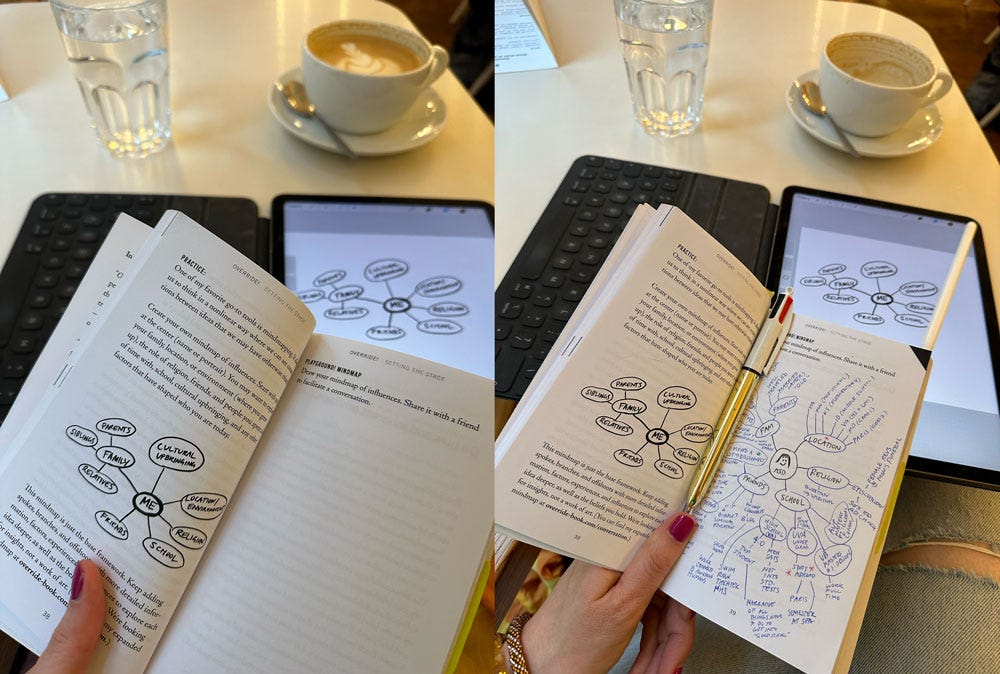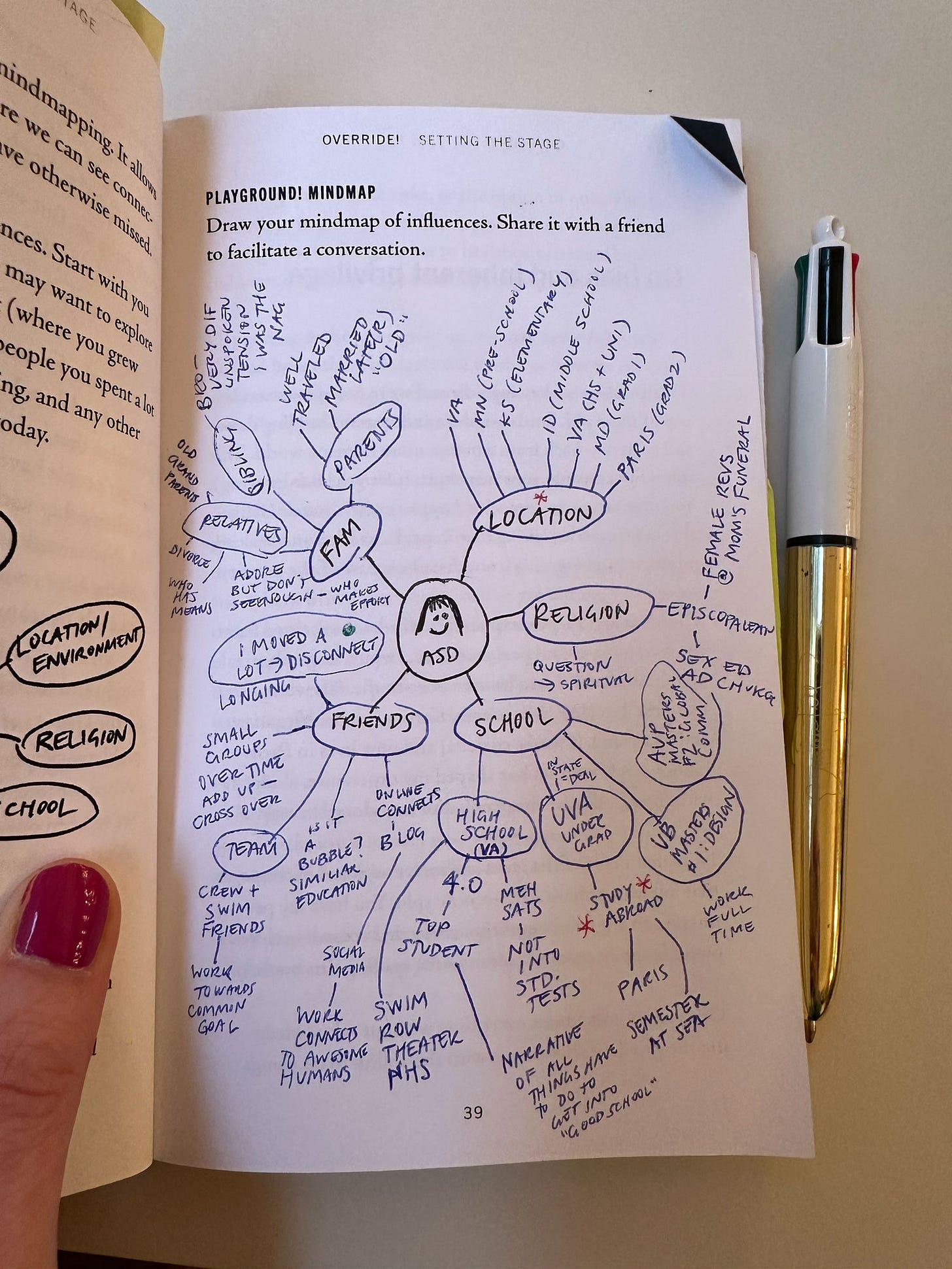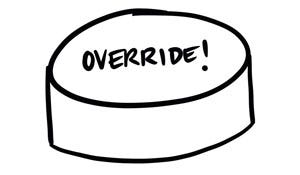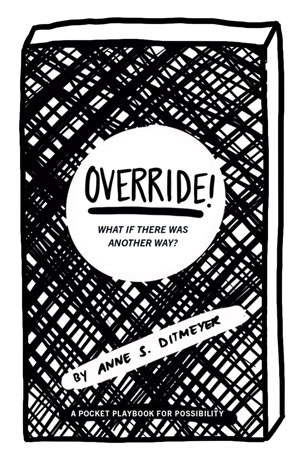EXERCISE: Mindmap of influences
An exploration of what has influenced the way we think. Some of it may serve us. Some of it needs an override.
If you’ve read OVERRIDE! What if there was another way? one of the early exercises is the mindmap of influences playground page (p. 39) in the chapter An incomplete list of what shapes us. I love mindmaps because they help us extract information and explore ideas in a non-linear way. Every time I make one I have new unexpected insights as I see new patterns and connect the dots.
I shared a template base for the mindmap in the book to spark some ideas and explore influences in our lives. I intentionally didn’t want to share my mindmap in the book because I didn’t want to influence people too much. I always remind participants in my workshops that the way that I respond to an exercise doesn’t mean it’s the only way or the right way. I always love seeing how you take the prompts and put your own spin on them.
I like to think of all the exercises in the book as a first draft. Often people can hesitate to start because they want it to be perfect. Really, it’s more important to get something out and onto paper than it is to have a “perfect” map (there is no such thing)! You need to start somewhere if you’re going to make change.
It was intentional to make a book that is pocket-sized so it’s light and easy to travel with. However, I acknowledge that makes the pages smaller to write on (and not everyone practiced writing in tiny handwriting like I did as a kid). You have full permission to get creative on how you do this. You may want to add post-its, or even slide in a tri-fold piece of paper which you can unfold to see your map. You also can keep a separate folder of exercises on full-sized paper so you have more space to play with. (Please comment on this post with your mindmaps! I always love seeing what people come up with.)
For me, I always work in pen or marker to start as a way to not overthink it. Because I can’t erase it, it means I’m less precious about it (handy for overriding perfectionist tendencies). I also love using my Bic 4-color pen for the exercises in the book because I could use different colors to mark up my mindmap, and surface themes and the influences that really shaped me. (Future dream collab: Bic pens + banana mapping event! Bic ballpoint pens are also ideal for banana mapping.)
Without further ado, here’s my mindmap! As you can see, it’s OK if it gets a bit messy or you have to turn the page to make something fit.
Psst. Did you notice that there’s a black triangle in the corner on the playground pages? You can fold it down to help you find the exercise!
Here’s what my mindmap reminded me of:
Travel is a huge influence in my life. Both parents traveled extensively before getting married (on the older side). It’s second nature to me. (Ironically, my brother doesn’t have the same travel bug.)
I saw the insecurities I had (self-inflicted) as a kid from having “older” parents (funnily enough when I reconnected with childhood friends last year after 30 years, I realized multiple other friends had similarly aged parents).
Where I’ve lived has shaped me a lot (DC, Minnesota, Kansas, Idaho, Virginia, Maryland, and Paris) and meant I had to learn to adapt and readapt a lot over the years (and probably why I’m not eager to have to start over as an adult—unless it feels right). It’s also where on a friend level I first learned to feel disappointed, disconnected, and longing when friends didn’t keep in touch to the level I did. I wasn’t able to articulate that sadness at the time.
My two semesters abroad in college very much shaped me and how I see the world. (My mom had studied and worked abroad, and I always knew studying abroad was more exciting than where to go to college). Both helped me see the city as my classroom, which very much influences the work I do today.
Exploring friend dynamics made me reflect on the importance of feeling part of a team, particularly through sports (swimming and rowing), and I also felt part of something when I did theater in high school. The friend category also made me reflect on how much I was or was not exposed to people with ideas and backgrounds different than mine.
I grew up knowing going to a good school was the goal. I was a top student, but my standardized test scores were not stellar. It’s no wonder many of us grew up with the “I’m not good enough” mentality. I’m grateful I always knew I was more than a test that required filling in bubbles that were read by a machine. It’s also clear how we were trained in high school to “do it all”—sports, activities, clubs, not to mention actual school work. Did we ever rest? Thankfully I think I did most of it because I wanted to, not because I felt like I had to to feel included.
Religion doesn’t resonate with me in a major way. It never fully clicked for me. I’m also not sure that having to take sex ed through a church group was super helpful for me (it wasn’t directly shaming, but it didn’t normalize pleasure). In hindsight, it was very non-memorable for me, but probably played into early shame of not wanting to talk about the subject.
I’m curious. What came up for you?
Here are some more reflection prompts to get you thinking:
What did you notice?
What themes, threads, or throughlines do you see? (Take another colored pen, marker, or highlighter to bring attention to some of those key influences.)
What surprised you? Did anything bubble up that you had forgotten about?
What has shaped you that supports you?
What has shaped you that you’re ready to let go of?
I do encourage you to try to think back to when you were young (a kid) as you explore on your mindmap to see if there are any memories that shaped you. In writing that sentence, I was reminded of second grade when I’d cry because I didn’t want to go to school. This was particular because I actually liked school. There was something anxiety-inducing about actually getting there. (The solution at the time was having a neighbor girl in our carpool drop me off at the classroom—it worked!). I was young at the time, but I’m curious if I was picking up any of the energy of schooling that didn’t work for me (early seeds of override!). To explore….
Another thing to keep in mind is what other categories would you include on your mindmap (hopefully you already added them!). After I “finished” my mind map I realized MEDIA or even POLITICS would have been interesting ideas to explore.
Did your family get the newspaper growing up? Were there multiple channels in which you received the news (newspaper—national/local, magazines, radio, tv—public/private/certain voices)? Was it balanced or did it have a political slant? Do you felt like you were exposed to a wide variety of world views, or one set perspective? How did where you grow up link to what news and media you received? (See, it’s all connected!) How did the news link to politics in your family? Have you always voted like your parents? Have you ever veered? Have you been encouraged to do your own research on candidates? Was there tension in your family growing up? What is talked about openly in your family? What is not?
See! Your preliminary mindmap just touches the surface. We’re never truly finished with these explorations, but having something will give you new information as you make decisions moving forward. Hopefully it will help bring more unlocking ideas to the forefront.
You’re welcome and encouraged to revisit your mindmap at any time and add to it. You also can make a new one, or take one of the categories and make a mindmap unique to that idea in order to dig deeper.
OVERRIDE! is all about unlocking layers. How you get there doesn’t matter. It often happens gradually over time. It’s why the book is designed to come at ideas from different directions through the exercises inside.
The possibilities are endless! The key is taking action (in this case write it down to start, get it out of your head) rather than only thinking about it. Action is how change happens.
When you share with a friend or talk through insights with someone else we often get new ideas that we can add to ours. Sometimes it’s the same idea, and other times something someone says will spark a totally different path for us to explore. The more honest we are with ourselves and with ourselves, I’ve come to see good things happen!
Continue the conversation!
If you’re open to it, share your mindmap in the comments of this post. (Bonus points if it’s a photo of the page in the book!) Otherwise, I invite you to share a reflection or insight in the comments (be as specific or general as you feel comfortable with) from doing the exercise.
Here’s some other fun stuff linked to OVERRIDE! coming up soon:
+ It’s not too late to join this weekend’s La Vie Creative Book Club with Krystal Kenney (RSVP required—linked at the bottom of the post. Don’t worry if you haven’t read or bought the book, you’re still welcome!). I’ll be Zooming in on Sunday, September 29th at 5pm CET/Paris to talk all things OVERRIDE!, answer any questions, and of course, banana map! Be sure to catch the recent podcast episode of “La Vie Creative” where I talk about how the book came to life.
++ I’m part of Jenner Linden’s 8-day ReWilding (online) retreat starting on October 7th. It’s free to join my workshop (Oct 10) and all the workshops if you sign up before midnight MDT on October 7th. I take a spin on a couple of exercises in OVERRIDE! for the workshop (hint: you’ll need a banana!). There’s also an episode of Jenner’s podcast “Enter the Portal” where I discuss OVERRIDE! coming soon!
+++ Mapping Your Path into 2025 is kicking off very soon! October 4th to be exact. It’s a 3-month workshop + community that embodies so many of the ideas explored in OVERRIDE! Each month we’ll explore different creative exercises in live workshops, and connect in small group calls and the community space. It’s seriously the most incredible global community! Use the code FOLLOWYOURCURIOSITY at check out for 111€ off.






